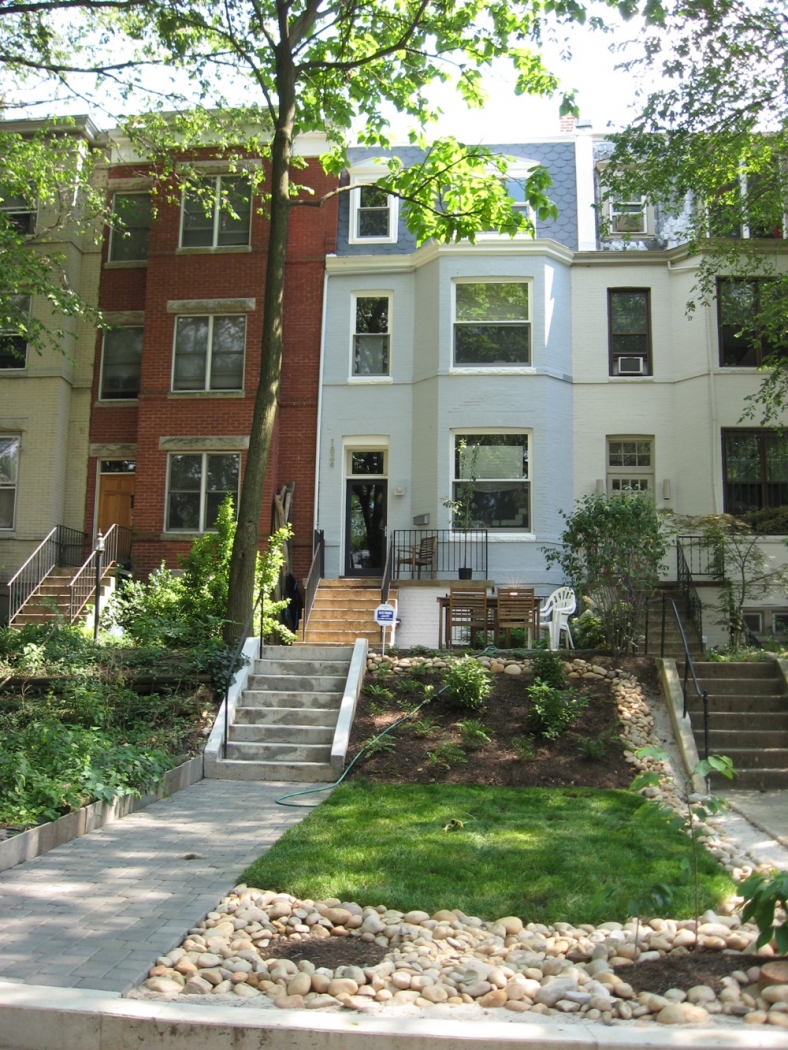
Image Credit: Amy Levin
Image Credit: Amy Levin Photo of the Levin basement during construction. You can see the transition from brick to cast concrete indicating where they dug down 4 feet and underpinned to achieve a full-height basement for an independent rental basement apartment, very typical of DC rowhomes. Note that in the next photo of the finished basement, the brick-concrete wall is left as is for a structure-as-finish aesthetic.
Image Credit: Amy Levin This photo shows Amy Levin's finished basement (one-bedroom rental apartment). Proper detailing of the foundation during the retrofit makes this space comfortable and dry.
Image Credit: Amy Levin The full cabinet set and granite countertop in Amy's basement apartment are reclaimed from an apartment building demolition. Total cost = $500.
Image Credit: Amy Levin This photo shows the first floor from the entrance looking back toward what was the kitchen and dining area.
Image Credit: Amy Levin Photo of the finished 1st floor, looking from the front entrance all the way through to the kitchen at the back of the house. Note how replacing the existing stairs with the open staircase makes the long and narrow rowhome dimensions less pronounced.
Image Credit: Amy Levin Photo of the kitchen as it appeared just prior to the start of gut rehab.
Image Credit: Amy Levin The finished kitchen featuring: concrete counters, reclaimed black walnut trim, and the salvaged mulberry breakfast bar surface from TreIncarnation.
Image Credit: Amy Levin "This is the powder room where we used wood from the original structure to make the vanity top which cost about 50$ to make...far less than the 500-800$ ones i saw new ;-)" (quoted from Amy Levin)
Image Credit: Amy Levin Photo of the finished dining area on the 1st floor, featuring two of the EJ Martin paintings salvaged during Amy Levin's gut rehab.
Image Credit: Amy Levin Photo of 2nd floor during demolition, looking toward the back of the house. Not much you can do about the plaster other than landfill disposal although fortunately pretty benign C&D waste. If not reused in her home, Amy made sure that items like the beautiful five-paneled door were taken to The Community Forklift. And that staircase to the left? When asked about its salvage, The Community Forklift advised that it was of highest value if salvaged as a unit--railings, trim, treads and frame. And so it was.
Image Credit: Amy Levin Photo of the finished 2nd floor, looking to the back of the house. A guest bedroom is to the right. Note how much the stair system opens up the tight hallway.
Image Credit: Amy Levin This photo shows Levin's upper-story utility room. Note that both the clothes washer and tank water heater are panned and plumbed with a drain. This measure is a durability requirement within the LEED for Homes rating system. When I remarked on this during a tour of Amy's home (I was one of the prime advocates for the durability content in LEED for Homes) Amy said, "Cool; just seemed like a really good idea to me. More of the why not approach Levin took toward LEED for Homes.
Image Credit: Amy Levin This photo shows the rooftop plastic-wood composite deck and the evacuated tube solar collectors just behind the AC compressors.
Image Credit: Amy Levin Floor plan for Amy Levin's redesigned basement and 1st floor.
Image Credit: Amy Levin Floor plans for redesigned 2nd & 3rd floors. Amy notes that this one drawing hides the 20 or so that preceded it. Moving from the original layout to this final one was a long and challenging process.
Image Credit: Amy Levin Amy used the EPA Home Energy Yardstick to compare her home energy consumption to other homes like hers. Her results show a solid score of 8.6 out of 10 (10 being the most energy efficient). Amy likes to think that her home's greenhouse gas emissions equivalent to 1 car is offset by the fact that her partner does not own a car! Note: Since her living space and the basement rental are separately metered, the next image shows how her basement rental apartment fares.
Image Credit: EPA Energy Star Amy ran the EPA Energy Star Yarstick on her basement rental unit as well and how about that: her renter has an even more energy efficient unit than Amy does living above (with the basement score being 9.2 compared to Amy's unit above being 8.6).
Image Credit: EPA Energy Star One of Amy's favorite EJ Martin's pieces.
Image Credit: Amy Levin
Green realtor Amy Levin uses her background in construction, housing market savvy, and sheer will to achieve Platinum on her LEED for Homes gut rehab of a DC rowhome
“It was easier than I thought,” says Amy Levin when first asked about her LEED for Homes Platinum gut rehab. This would not be the last time my jaw would drop when dealing with Amy; she is a completely unflappable, sharp as a tack, force of nature. She is a born problem-solver and her favorite retort is most certainly “why not” rather than “why.” The devil is always in the details; here is the rest of the context on Amy’s “easy” version of LEED Platinum.
Using the LEED for Homes checklist to drive the process
Amy used the LEED for Homes rating program and checklist to drive her own green building learning curve as well as her design and building process. “I had done some green building in the past,” recalls Amy, “but it was not a comprehensive or integrated process. We did not use the LEED for Homes checklist as prescription, we used it to learn, evaluate, and prioritize. The LEED for Homes program checklist is a really great organizational tool.”
“While this approach is not the ideal, it is quite common and can work” says Asa Foss, Amy’s LFH rater, her primary green building consultant and now Manager for LEED Technical Development at the USGBC. “The danger in having the checklist in the driver’s seat is turning your project in to a point-chasing exercise. While point-chasing was definitely not an issue with Amy’s project, it’s an important hazard to avoid.”
Fully utilizing local green resources
Amy is quick to point out that she was fortunate during her project. “First,” says Amy, “I had Asa as my ace; his availability, knowledge, and willingness to work with me as the general contractor was a huge green advantage.” “And discovering local resources like Marcus Sims (Treincarnation) and The Community Forklift were key for green rehab.” TreIncarnation supplied lots of surplus salvage finish materials and The Community Forklift’s salvage retail operation was a great two-way street for the project, taking from and supplying to Amy’s project.
Making the numbers work
While Amy had a substantial budget for her project, it was definitely finite: “My budget was $500,000 and we came in at $495,676.92. I kept expecting the green building BigFoot to come and crunch the project, but I really believe that there was no real premium. Think of it this way: my apartment rental income covers more than what my mortgage would be on this project. My peak monthly utility bills are less than half those of my neighbors, and my home is more comfortable with better air quality.”
Amy is clear that some individual components came at a premium: higher SEER AC unit, her solar water system, top-of-the-line household appliances. But here is a list of project elements where she is sure she saved money going green: a salvaged kitchen cabinet and granite countertop for her rental unit kitchen ($500), powder room vanity made from site-salvaged lumber ($50), river-run fieldstones for front yard landscaping (free from her 4 feet of basement excavation).
And as a realtor, Amy is confident she can take the value of her LEED Platinum project with her if and when she sells her home. “There is real value here that I can show, from the comfort and health perspectives, but also by simply sharing my utility bills!” says Amy with a smile.
An interesting twist: Salvaging art as well as the building
The emphasis on salvage is pretty clear in Amy’s home: the reuse of the original heart pine flooring, rough framing planed and used for the powder room ceiling exposed latticework, the upstairs laundry framed with salvaged two by fours. But the most impressive and unique salvage during the project was not building materials. It was the paintings of EJ Martin that Amy discovered half-buried in the dirt of the basement and even behind drywall from previous renovations. EJ Martin lived at 1834 Ingleside Terrace for many years, at times even paying his rent with his work.
“They were far too beautiful to toss,” says Amy. “It was more than worth it to restore what we could and keep them with this house.” EJ Martin’s paintings are hung throughout Amy’s home.
Weekly Newsletter
Get building science and energy efficiency advice, plus special offers, in your inbox.
Lessons Learned
Amy was not particularly fond of being a green guinea pig for some of her materials. “The Columbia Forest Product Purebond door on the largest cabinet never worked; it warped badly,” says Amy, "and we finally just had to replace it.“
“I also completely underestimated the need for residential lighting design,” adds Amy. “We got energy-efficient lighting products, but the location of lighting is sometimes an issue and also the balance of task and background lighting is wrong.” Amy wishes she had known about residential lighting design guidance from IBACOS (High Performance Lighting Guide) and from RPI (Builder’s Guide to Home Lighting).
“Frankly,” says Amy, “it was the regular headaches that had little to do with green that I wish I could do over again, like finding the right plumber!” Amy wrapped up by saying how hard it is to figure out the right way to “divvy up” four stories of a rowhouse between the rental and the live-in portions.
General Specs and Team
| Location: | Washington, DC |
|---|---|
| Bedrooms: | 5 |
| Bathrooms: | 3 |
| Living Space: | 2600 |
| Cost: | 190 |
| Additional Notes: | The rowhome has a finished basement that is a fully independent rental unit, quite typical of the area. |
General Contractor - Amy Levin Builder - Leon Home Improvement Insulation contractor - Anchor Insulation Electrician - Michael n Sons HVAC - Argent Heating and Cooling Renewable energy systems contractor - Capitol Sun Group
Construction
Energy
Energy Specs
- Air tightness = 4 ACH50
- Heating efficiency (heat pumps): 9.0/8.2 HSPF
- Cooling efficiency (heat pumps): 17 SEER
- All ducts in conditioned space
- Water heating: 0.82 EF (see below for solar water heating)
- Energy Star windows (U-value=0.3; SHGC=0.29) (glazing to floor ratio=12%)
- Seagull Energy Star Lighting
- KitchenAid Energy Star appliances
- Evacuated tube solar water system (supplying 77% of total hot water)
NOTE: Jeldwyn Doors and Marvin Windows from Midsouth Building Supply Co. (only companies meeting size and historic requirements)
NOTE: All sealants from AFM Safecoat
Water Efficiency
- Limited turf: 17% of landscaped area
- Drought-tolerant plantings: 100%
- Roof rainwater harvesting system: 63% of roof area
- High Efficiency Fixtures (toilets, faucets, showerheads)
NOTE: All plumbing supplies, including Toto dual-flush toilets, from Thomas Somerville
Indoor Air Quality
- Ducts sealed off during construction
- Home flushed continuously for one week prior to occupancy (windows open)
- No attached garage
- MERV 13 air filter
Green Materials and Resource Efficiency
- Framing waste factor = 0%
- Advanced framing techniques
- Construction waste diversion rate = 90%
- Salvaged heart pine flooring
- Salvaged kitchen countertop and cabinet set (basement rental unit)
- Site-salvaged river stones for landscaping
NOTES:
a. Metal stairs with FSC-certified treads from The Iron Shop
b. Paint - Harmony
c. FSC-certified interior doors- MidSouth Building Supply
d. Concrete - Fly ash, recycled aggregate: DC Materials
e. Cabinets - Eco Green Living
f. Countertops and bath sink Eycon
g. Recycled ceramic tile - Nature Neutral
h. Trex decking - MidSouth Building Supply
Certification
LEED for Homes Platinum Rehab (Click here for Amy Levin's Final LEED for Homes checklist)
HERS Rating = 63

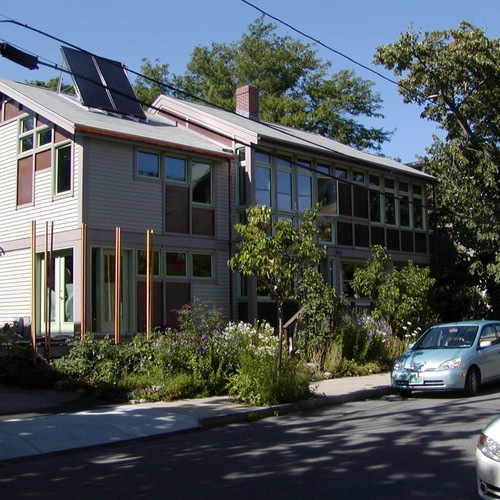
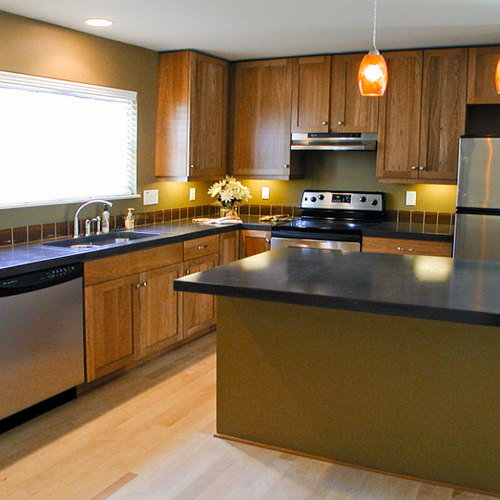
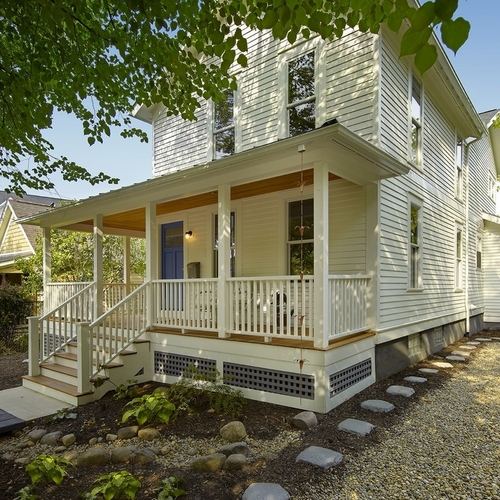
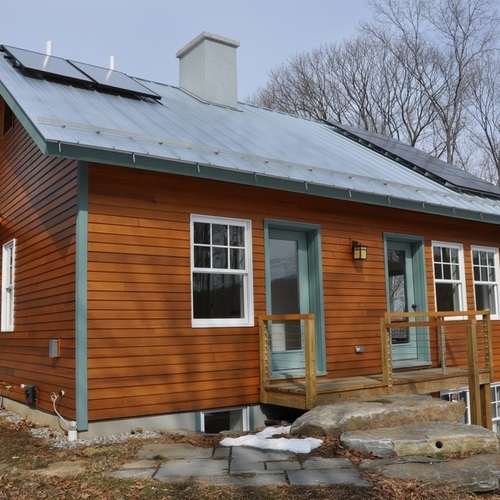






15 Comments
LEED Rehab
Wow! I am so impressed with the drive and dedication it took to take on and complete this project. It gives me hope that this is something I might be able to tackle some day, without glossing over the inevitable frustrations that can go along with home "rehab". Thanks for the great information and the excellent list of resources!
We love it!
We rent the apartment in the basement and love the space, the low utility costs, and the fact that it's hurting the environment less. Plus, Amy really is great!
Great House!
I have seen the renovated home above, but had never seen pictures before the renovation. I was amazed at all the work that was done. Nice job putting in the time and effort to make the home more eco friendly. The house looks great !
Uber Cool Reno
I have had the thrill of visiting and enjoying Amy's home. It's truly unbelievable. Had no idea about the paintings. Also had no idea what the space looked like BEFORE. Wow! What a transition. For those who know Amy, the results really aren't that surprising. She's amazing. Thanks for highlighting her talents and dedication to eco-friendly design and rehab.
nice work!
i've seen this house many times and its a beaut! hoping to see more like this one in dc.
Very impressed!
Great piece! And wonderful inspiration for others who might be considering such a conversion but feel daunted by the idea.
Amy was my ROCKSTAR realtor
Love ya girl!!! You are an inspiration!
WOW!!!
Many thanks to all of you fabulous folks-especially Peter Yost for doing such an awesome and thorough job on this case study! I'm truly thankful for the opportunity to turn my home into a helpful example for others AND to have a beautiful place to call home! Days like this make it all worth it. THANK YOU!
go!
Good article, awesome house and good example for others to follow!
Great article!!
I had the pleasure of living in this gorgeous house during my stay in DC, and it's no surprise to me that Amy was able to achieve so much with it. The house is much like it's owner: warm, one-of-a-kind, and environmentally conscious. Congrats, Amy, on this article! It's great to read about your incredible accomplishment.
Very cool!
Have known Amy since she was two. It is terrific to see this wonderful and environmentally conscious project of hers.
Wow
That's a huge project, and beautifully done. So impressive!
Energy Yardstick
The last few photos show an Energy Yardstick for the two units. That looks interesting. How do you go about doing that?
EPA Home Energy Yardstick
Hi Joel -
You just go to the EPA website and enter in the info for your residence and its a web-based tool that cranks out the results, as shown. http://www.energystar.gov/index.cfm?fuseaction=HOME_ENERGY_YARDSTICK.showGetStarted
There is also another tool that has a more detailed option where you input a lot more info about your home and get more honed results. It's called the Home Energy Saver: http://hes.lbl.gov/consumer/
Finally took the time to take
Finally took the time to take a real close look at this. This is a wonderful piece, and a well desired tribute to your super project! I know the blood, sweat and tears (not to mention money) that went into this, and it is clearly well worth the effort. All the best in your green home, and may you reap the fruits of your labor for many years to come.
Log in or create an account to post a comment.
Sign up Log in